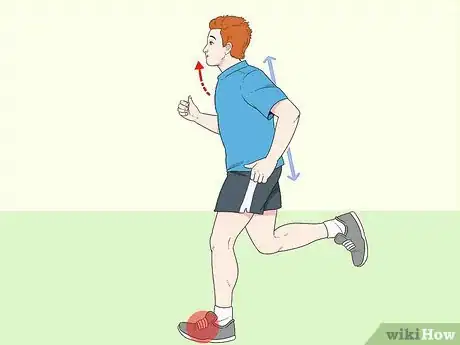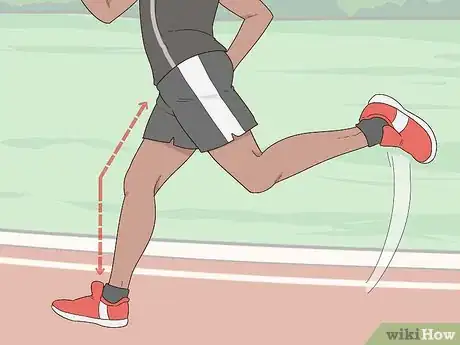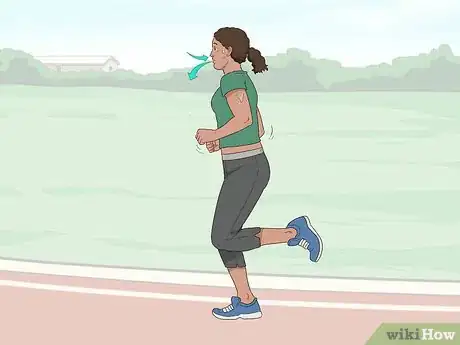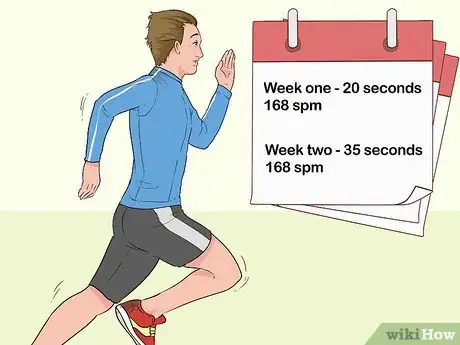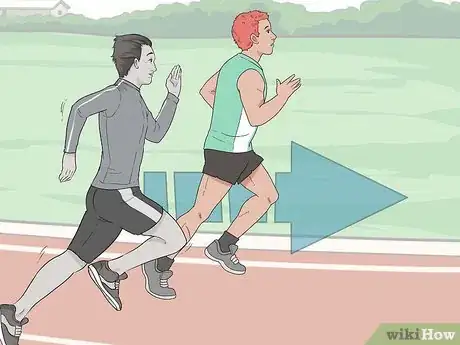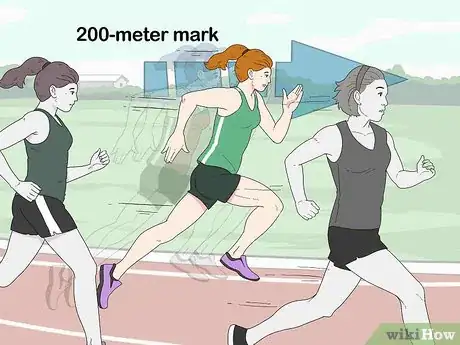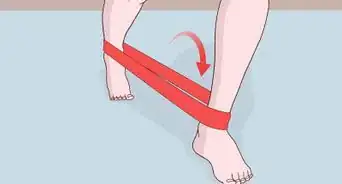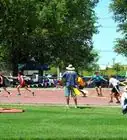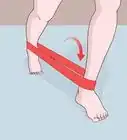This article was co-authored by Francisco Gomez. Francisco Gomez is the Head Coach at the FIT Potato Gym, a training gym established in 2001 in the San Francisco Bay Area. Francisco is a former competitive runner who helps endurance athletes train for major marathons like the Boston Marathon. Francisco specializes in Injury Rehab, Flexibility, Marathon Training, and Senior Fitness. He has a B.S. in Nutrition and Exercise Physiology & Running.
There are 7 references cited in this article, which can be found at the bottom of the page.
wikiHow marks an article as reader-approved once it receives enough positive feedback. In this case, 80% of readers who voted found the article helpful, earning it our reader-approved status.
This article has been viewed 308,111 times.
The 1500m race is one of the longer races in track. Since it is a longer run, having the correct form is very important. Running properly will help you conserve energy and run more efficiently, as well as faster. By increasing your cadence, i.e., your steps per minute, you will also be able to run a faster 1500m. Running strategically during the race should also improve your performance.
Steps
Technique
-
1Avoid looking down. Looking down while running can reduce your speed substantially. It also creates tension in your shoulders and neck. Instead, look straight ahead by focusing on a point 30 to 40 meters (100 to 130 feet) ahead of you. Maintain this position throughout the run.[1]
-
2Keep your shoulders relaxed. Your shoulders should be down and back, not hunched. If you begin to feel your shoulders hunch, relax them immediately.[2]
- Running with hunched shoulders can restrict your breathing.
Advertisement -
3Bend your elbows at a 90-degree angle. Your arms should be relaxed at your sides with your elbows bent at a 90-degree angle. As you run, swing your arms forward and back in a straight motion. Try not to let your arms cross in front of your chest as you run. This movement will waste energy and slow you down.[3]
- Swinging your arms in a straight forward and backward motion will help propel you forward.
-
4Relax your hands. Your hands should be relaxed as well. Avoid clenching them into fists while you run. Instead, keep them in a relaxed fist with your thumbs resting on top of your fingers.[4]
-
5Lean slightly forward. As you run, keep your back straight and lean forward slightly. This will not only help you propel yourself forward, but it will also help you land on the middle of your foot instead of your heel.[5]
-
6Level your knees. While you run, try to avoid lifting your knees higher than your hips. Instead, keep them level at your hips. When your foot lands on the ground, try to land with a slight bend in your knee. This will help absorb some of the impact. [6]
- Remember that your knees should be moving forward, not upward.
-
7Land on the middle of your foot. Do this instead of landing on your heel or your toes. Landing on the middle of your foot will help you lift it faster, and thus, you may be able to run faster.[7]
- Additionally, when your foot hits the ground, it should land below your hips.
-
8Synchronize your breathing. For medium intensity running, aim for two steps while breathing in and two steps while breathing out. For high intensity running (like during the final stretch of a race), aim for one step while breathing in and one step while breathing out.[8]
- Make sure to use both your nose and mouth when inhaling to get the maximum amount of oxygen into your body.
- Try to avoid shallow breathing. Focus on breathing deeply by pushing your stomach out as you inhale and contracting it as you exhale.
Cadence
-
1Calculate your cadence. Set your watch to one minute and run at a normal pace. As you run, count the number of times your left or right foot hits the ground. When the timer stops, multiply this number by two.[9]
- For example, if your right foot hit the ground 80 times, then your cadence is 160 steps per minute (spm).
-
2Increase your cadence gradually with interval training. In your run, incorporate 20-second intervals of running that are five percent faster than your normal cadence. If your normal cadence is 160 spm, for example, then incorporate an interval of 20 seconds at 168 spm during your regular run. After 20 seconds, slow back down to your normal pace.[10]
- Practice this three to five times a week.
-
3Increase the interval at which you run your new cadence. Once you are comfortable running 20-second intervals, increase them by 15 seconds. If you ran for an interval of 20 seconds at 168 spm during week one, for example, then increase the interval to 35 seconds of 168 spm during week two. [11]
- Repeat this until you can run the whole minute at 168 spm.
- Once you are comfortable running at your new cadence, then increase it by another five percent and repeat the process over again.
-
4Use a metronome. A metronome will help you find your rhythm while you run. Set the metronome to your desired beats per minute, for example 160 bpm if your cadence is 160 spm. Keep your running rhythm in time with the metronome.[12]
Strategy
-
1Establish a position in lane one or two. If you're running in the top 5-10% of the competition, you should position yourself in the outside of lane one or inside of lane two. Establish your position as soon as possible upon starting the race.[13]
- Make sure to position yourself near the front of the pack as well.
-
2Maintain a steady pace. During the middle of the race, position yourself behind the leaders and maintain a steady pace. This way, if you are running against the wind, the leaders’ bodies will block most of it, helping you to conserve energy.
- Additionally, make sure to pay attention to the leaders. Only speed up your pace if the leaders speed up their pace.
-
3Accelerate your pace. When you have 300 meters left to run, accelerate your pace. Once you hit the 200-meter mark, accelerate to an all-out sprint. If you are behind the leaders at this point, then move yourself to an outside lane and propel yourself forward to get ahead. Maintain your speed until you reach the finish line.
- Make sure you stay in the second or third lane at the 300-meter mark to avoid getting boxed in.
Expert Q&A
Did you know you can get expert answers for this article?
Unlock expert answers by supporting wikiHow
-
QuestionIs it possible to improve your speed in a week?
 Francisco GomezFrancisco Gomez is the Head Coach at the FIT Potato Gym, a training gym established in 2001 in the San Francisco Bay Area. Francisco is a former competitive runner who helps endurance athletes train for major marathons like the Boston Marathon. Francisco specializes in Injury Rehab, Flexibility, Marathon Training, and Senior Fitness. He has a B.S. in Nutrition and Exercise Physiology & Running.
Francisco GomezFrancisco Gomez is the Head Coach at the FIT Potato Gym, a training gym established in 2001 in the San Francisco Bay Area. Francisco is a former competitive runner who helps endurance athletes train for major marathons like the Boston Marathon. Francisco specializes in Injury Rehab, Flexibility, Marathon Training, and Senior Fitness. He has a B.S. in Nutrition and Exercise Physiology & Running.
Fitness Coach
-
QuestionWhat's the point of taking an ice bath after a running competition?
 Francisco GomezFrancisco Gomez is the Head Coach at the FIT Potato Gym, a training gym established in 2001 in the San Francisco Bay Area. Francisco is a former competitive runner who helps endurance athletes train for major marathons like the Boston Marathon. Francisco specializes in Injury Rehab, Flexibility, Marathon Training, and Senior Fitness. He has a B.S. in Nutrition and Exercise Physiology & Running.
Francisco GomezFrancisco Gomez is the Head Coach at the FIT Potato Gym, a training gym established in 2001 in the San Francisco Bay Area. Francisco is a former competitive runner who helps endurance athletes train for major marathons like the Boston Marathon. Francisco specializes in Injury Rehab, Flexibility, Marathon Training, and Senior Fitness. He has a B.S. in Nutrition and Exercise Physiology & Running.
Fitness Coach
-
QuestionHow do I train when I want to improve my running ability?
 Michele DolanMichele Dolan is a BCRPA certified Personal Trainer in British Columbia. She has been a personal trainer and fitness instructor since 2002.
Michele DolanMichele Dolan is a BCRPA certified Personal Trainer in British Columbia. She has been a personal trainer and fitness instructor since 2002.
Certified Fitness Trainer
References
- ↑ http://www.nhs.uk/Livewell/c25k/Pages/how-to-run.aspx
- ↑ Francisco Gomez. Competitive Runner. Expert Interview. 24 October 2019.
- ↑ http://www.nhs.uk/Livewell/c25k/Pages/how-to-run.aspx
- ↑ https://www.youtube.com/watch?v=e7m205ZIxBE
- ↑ http://www.nhs.uk/Livewell/c25k/Pages/how-to-run.aspx
- ↑ https://greatist.com/move/how-to-run-properly-mistakes
- ↑ https://www.youtube.com/watch?v=e7m205ZIxBE
- ↑ https://www.runtastic.com/blog/en/sports-fitness/how-to-breathe-properly-while-running/
- ↑ https://runnersconnect.net/heelstriking-running-cadence/
About This Article
To run a fast 1500 meter race, which is one of the longer track races, focus on proper form. Keep your gaze straight ahead by focusing on a point 30 to 40 meters ahead of you to increase your speed and keep your neck relaxed. You’ll also want to relax your shoulders by keeping them down and back, which will allow you to breath more easily and deeply. Move more efficiently by swinging your arms in a straight forward and backward motion and leaning slightly forward from your hips. For more tips from our Personal Trainer co-author, including how to increase your cadence to run faster, keep reading!





